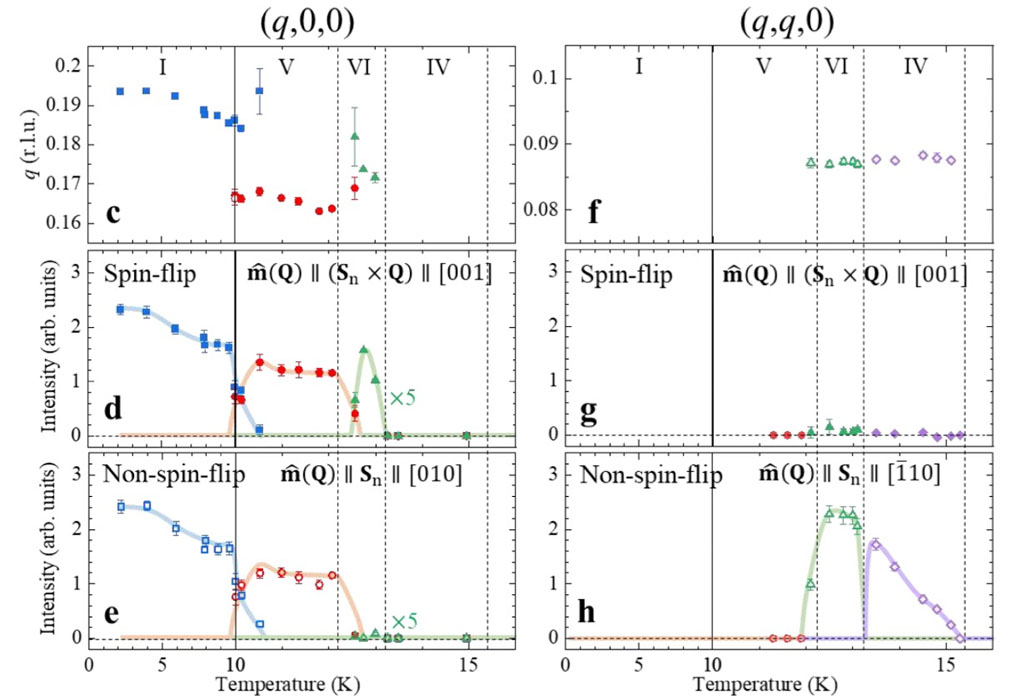Topological Spin Orders in a Centrosymmetic Tetragonal Magnet EuAl4 Investigated by Polarized Neutron Scattering
PI of Joint-use project: R. TakagiHost lab: Neutron Science Laboratory
Topologically nontrivial magnetic orders have been intensively investigated since the pioneering work on magnetic skyrmion lattice in MnSi, in which Dzyaloshinski-Moriya (DM) interactions arising from the chiral crystal structure and ferromagnetic interactions lead to long-period modulated magnetic orders including the skyrmion lattice state. Therefore, the early studies on magnetic skyrmions were focusing mainly on ferromagnetic systems with broken spatial inversion symmetry. However, a recent study on an itinerant triangular lattice magnet Gd2PdSi3 [1] has revealed that centrosymmetric system can host magnetic skyrmion lattice owing to frustration in magnetic interactions or coupling between local magnetic moments and conduction electrons. In fact, subsequent studies have found the emergence of skyrmion lattice states in centrosymmetric magnets.
In the present study, we have found that EuAl4, which is also a centrosymmetric magnet, exhibits two distinct skyrmion lattice states in magnetic field [2]. This system has a tetragonal crystal structure belonging to the space group of I4/mmm. By applying magnetic field along the c axis below 15 K, the system shows successive field-induced phase transitions, which is accompanied by anomalies in Hall resistivity. This is indicative of the topological Hall effect arising from a non-coplanar magnetic structure like skyrmion lattice state. To determine the magnetic structures in the field-induced phases, we performed polarized neutron scattering in a magnetic field at TAIKAN instrument (BL15) in the materials and life science experimental facility in J-PARC. By utilizing supermirror neutron spin polarizer and analyzer, we measured spin-flip and non-spin-flip scattering intensities of magnetic Bragg reflections appearing in the small-angle region in a magnetic field of 1 T with varying temperature. As a result, we found that this system exhibits rhombic and square lattices of Bloch-type magnetic skyrmion lattices in a magnetic field. We have further investigated magnetic phase transitions in zero magnetic field using the polarized triple-axis neutron spectrometer PONTA in JRR-3. The spectrometer was operated in the Pzz longitudinal polarization analysis mode, in which the polarization direction of the neutron spins was set to be perpendicular to the horizontal scattering plane. Figure 1 shows the summary of the measurements at PONTA. We have identified four magnetic phases below 15 K in zero field. Phase I and V have the magnetic modulation wave vectors (q-vectors) of (q,0,0), while phase IV does (q,q,0). By analyzing the neutron spin polarization of the scattered neutrons, the low temperature phases (I and V) and the highest temperature phase (IV) are found to have screw-type and fan-type magnetic modulations, respectively. Interestingly, the intermediate phase, phase VI, has both (q,0,0) and (q,q,0) wave vectors. By assuming a multi-q magnetic order in this phase, a superposition of these wave vectors (and their counterparts (0,q,0) and (q,−q,0)) results in another topologically-nontrivial magnetic order, which is distinct from the well-known magnetic skyrmion lattice state. We would also like to emphasize that the modulation periods of these incommensurate magnetic orders are relatively short, specifically, 2-3 nm, which cannot be resolved by Lorentz transmission electron microscope. The present study also demonstrates that polarized neutron scattering is quite useful to study short-period topological magnetic orders.
References
- [1] T. Kurumaji et al., Science. 365, 914 (2019).
- [2] R. Takagi et al., Nat. Commun. 13, 1472 (2022).

